Types of Antique Tables
Antique tables aren’t just functional pieces of furniture, they’re reflections of how people lived, worked, gathered and entertained over the centuries. From formal desks made for study and account-keeping to purpose-made tables designed for social rituals like tea or card playing, each form tells a story about its period and purpose.
Materials, design and joinery evolved alongside changing domestic habits and stylistic movements. Whether made for work, display or hospitality, the best antique tables combine fine materials, considered design, practical utility, skilled craftsmanship and enduring charm.
As homes became more specialised and social customs became both more complex and defined, so did the tables that served them. The medieval trestle table, once dominant in great halls, gradually gave way to joined and framed forms in the 17th century; sturdier, more permanent pieces that laid the groundwork for later developments like drawers, drop-leaves, tilt-tops, and fitted interiors.
Georgian design brought classical symmetry and architectural restraint. Victorian makers expanded the field with more decorative styles and an increasingly diverse range of formats. By the late 19th century, tables existed for almost every domestic function, and were often built to an exceptional level of finish and durability.
Today, antique tables remain among the most adaptable and collectible types of period furniture. Below, you’ll find the main categories we offer, with links to explore each table type in more detail.
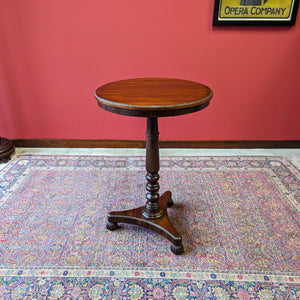
Antique Occasional Tables
Small, moveable tables, from tripod wine tables to tilt-top supper tables, designed for flexible use throughout the home, never needing to be tied to one fixed place or function.
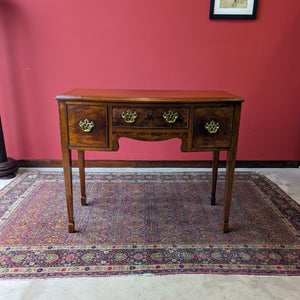
Antique Side Tables
Designed to sit more permanently in place, against walls or beside other furniture, side tables provide useful surfaces in halls, living spaces and bedrooms, tying a scheme together with their quiet presence.
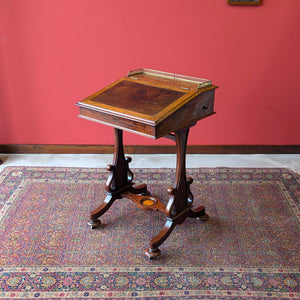
Antique Desks & Writing Tables
Purpose-built for work, these tables offered a dedicated space for thought, order and productivity.
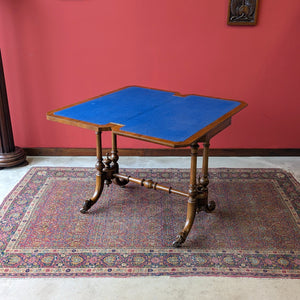
Antique Tea, Games & Card Tables
Tables made for entertaining, often with hinged tops that open to reveal a larger surface. Designed for social rituals, built to host and made to last.
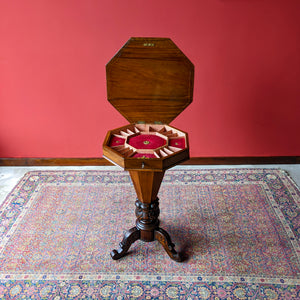
Antique Sewing & Work Tables
Compact, finely crafted and with built-in storage. Originally made for needlework and domestic tasks, now appreciated for their character, charm and everyday usefulness.
Evolution of Antique Tables by Period
Antique tables evolved dramatically across the long arc of British design history, reflecting changes in architecture, daily life and social customs. While often classified by type or use, understanding how styles evolved over time adds depth to both collecting and placement decisions. Here’s a quick overview of the key periods and what defined their approach to table design.
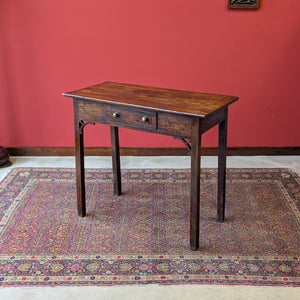
Georgian Tables (1714–1830)
Georgian design brought symmetry, proportion and a new level of precision to cabinetmaking, refining the more robust and organic styles of earlier periods. Tables from this period often feature clean lines, restrained ornament and well-selected timbers such as mahogany, oak and walnut, all carefully chosen for their colour, grain and workability.
As life in the home became more socially oriented, with an emphasis on hospitality and leisure, new table forms emerged to suit the evolving rituals of daily living.
The Georgian period saw significant innovation in table mechanics, with tilt tops, drop leaves and early extending formats becoming more widespread and better resolved. These innovations made tables more adaptable to changing domestic needs, and laid the groundwork for the more complex engineering that followed in the Victorian era.
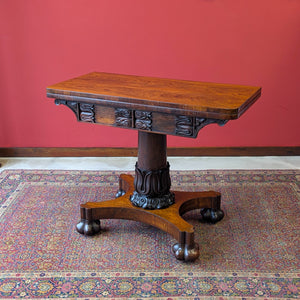
Regency Tables (c.1800–1830)
Regency tables were often neoclassical in tone, defined less by decoration than by architecture. This was furniture shaped by proportion and silhouette, emphasising line over ornament. Classical ideals and sophisticated understatement reinterpreted for modern living. More exotic woods became fashionable among elite makers, but discretion remained a virtue.
The best Regency tables were built to stand in well-planned rooms, structurally clever, finely scaled and rooted in classical ideals. Despite the short timeframe, Regency tables remain some of the most architecturally distinctive and collectible.
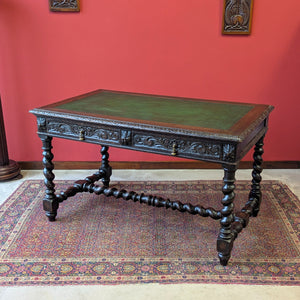
Victorian Tables (1837–1901)
The Victorian era saw furniture flourish in both variety and ambition. Advances in manufacturing and a growing middle class created demand for new table forms suited to a wider range of homes and habits.
Design became more eclectic and decorative, often blending influences from earlier styles with newly fashionable materials and finishes. Mahogany continued to feature prominently, though the period also embraced a wider palette, from richly figured walnut to intricate rosewood veneers and paler timbers chosen for contrast or effect.
Functionality expanded too. Drop-leaves, storage compartments, gate-leg actions and hinged supports became more sophisticated and widespread, reflecting the era’s appetite for innovation and convenience. While some late Victorian pieces veered toward excess or early mass production, the best tables from this period balanced solid craftsmanship with confident, expressive design.
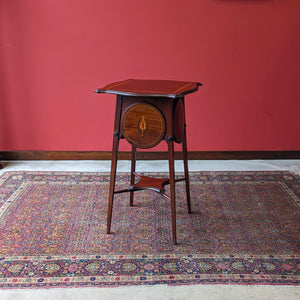
Edwardian Tables (1901–1910)
Edwardian furniture marked a return to lightness and clarity after the heavier forms of the Victorian era. Tables from this brief but distinctive period often reflect a synthesis of earlier styles, with the delicacy of Sheraton, the symmetry of Georgian design and flourishes of Art Nouveau, all reinterpreted for a more informal way of living.
Tables from this era often feature inlaid detailing, satinwood crossbanding and a focus on subtlety over grandeur. Mass production became more widespread and industrialised, but well-made Edwardian tables retained a very high level of craftsmanship and finish.
Proportions became slimmer, legs more tapered and decoration more reserved. Smaller occasional tables, display tables and writing desks became increasingly popular, aligning with evolving interior layouts and changing roles within the home.
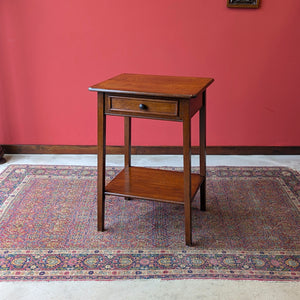
Early 20th Century Tables (1910–1930s)
Antique tables from the early 20th century reflect a transitional period between traditional craftsmanship and modernist influence. Art Deco introduced geometric lines, innovative veneers and bolder materials, while interwar and post-war pieces often simplified earlier designs.
Oak remained particularly popular, especially in utility tables, while smaller occasional pieces grew in popularity. These later antique tables can offer a distinct characterful feel, bridging period elegance with evolving 20th-century tastes.
Antique Tables FAQ
How do I know if an antique table will fit my space?
Check the full dimensions listed and allow for clearance around chairs, drawers or leaves if applicable.
Can I use an antique table every day?
Yes absolutely, most were made for regular use and have been in use their entire long lives. They will undoubtedly outlast most modern tables and will serve you incredibly well for potentially generations to come if looked after.
Are antique tables sturdy enough for modern use?
Well-made examples, either original or properly restored, are more solid than most modern pieces. We inspect every piece carefully to make sure it’s ready to be put to use in the home.
Do antique tables come fully assembled?
Most antique tables are fully assembled and cannot be taken apart. Some may have removable tops or legs which can be taken off but this is quite uncommon. We’ll always let you know in the listing if this is the case.
What’s the difference between side tables and occasional tables?
Side tables are usually static; occasional tables are lighter, often movable and designed for flexible use.
Do you deliver antique tables across the UK?
Yes, delivery is included for most of the UK. Once your order is placed we’ll dispatch the item to our courier who will call you in due course to arrange delivery with you directly at a suitable time. Delivery is normally around 5-12 working days.
How do I clean an antique table safely?
Use a soft dry cloth for daily dusting. For deeper cleaning, a light beeswax polish is best, no sprays or silicone.
Do antique tables need regular maintenance?
Not much at all if anything. Gentle cleaning and the occasional wax polish will keep them looking their best.
What’s a tilt-top table?
A table with a hinged top that folds vertically for storage, common across Georgian and Victorian designs.
What is a gateleg table?
A table with legs that swing out to support drop leaves, often used for dining or multi-purpose spaces.
Why are some antique tables veneered?
Veneers allowed for decorative patterns and use of rare woods while maintaining structural integrity with solid bases.
Is a 1920s table considered antique?
Yes, in the UK, “antique” typically refers to items over 100 years old. Early 20th-century pieces are just entering that range.
Every home needs a few good tables. Tables for living, working, entertaining and more. A beautiful, finely made antique table can handle all of it in style and they’ll certainly hold up to the job… most of these tables have outlasted empires afterall!
If one feels right for your home, you can buy online with UK delivery included. Want to talk it through first? We’re always happy to help, just get in touch.








































































